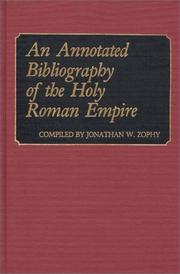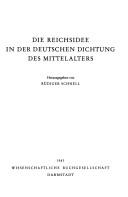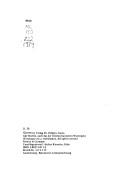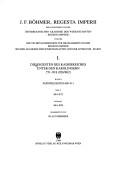| Listing 1 - 10 of 169 | << page >> |
Sort by
|

ISBN: 0313214573 9780313214578 Year: 1980 Publisher: Westport (Conn.): Greenwood
Abstract | Keywords | Export | Availability | Bookmark
 Loading...
Loading...Choose an application
- Reference Manager
- EndNote
- RefWorks (Direct export to RefWorks)
History of Europe --- Holy Roman Empire --- History --- Dictionaries --- -History --- -Dictionaries --- Dictionaries. --- Heiliges Römisches Reich Deutscher Nation --- Heiliges Römisches Reich --- Svi︠a︡shchennai︠a︡ Rimskai︠a︡ Imperii︠a︡ --- Imperium Romano Germanicum --- S.R.I. --- Sacrum Romanum Imperium --- Austria --- Germany

ISBN: 0313240280 Year: 1986 Volume: vol 3 Publisher: New York Westport London Greenwood
Abstract | Keywords | Export | Availability | Bookmark
 Loading...
Loading...Choose an application
- Reference Manager
- EndNote
- RefWorks (Direct export to RefWorks)
Holy Roman Empire --- -History --- -Bibliography --- Heiliges Römisches Reich Deutscher Nation --- Heiliges Römisches Reich --- Svi︠a︡shchennai︠a︡ Rimskai︠a︡ Imperii︠a︡ --- Imperium Romano Germanicum --- S.R.I. --- Sacrum Romanum Imperium --- Austria --- Germany --- History --- Bibliography. --- Bibliography

ISBN: 3412105007 Year: 2001 Publisher: Köln : Böhlau,
Abstract | Keywords | Export | Availability | Bookmark
 Loading...
Loading...Choose an application
- Reference Manager
- EndNote
- RefWorks (Direct export to RefWorks)
Holy Roman Empire --- -Holy Roman Empire --- -History --- Heiliges Römisches Reich Deutscher Nation --- Heiliges Römisches Reich --- Svi︠a︡shchennai︠a︡ Rimskai︠a︡ Imperii︠a︡ --- Imperium Romano Germanicum --- S.R.I. --- Sacrum Romanum Imperium --- Austria --- Germany --- History

ISBN: 3534083873 9783534083879 Year: 1983 Volume: 589 Publisher: Darmstadt Wissenschaftliche Buchgesellschaft
Abstract | Keywords | Export | Availability | Bookmark
 Loading...
Loading...Choose an application
- Reference Manager
- EndNote
- RefWorks (Direct export to RefWorks)
German literature --- Civilization, Medieval, in literature --- History and criticism --- Holy Roman Empire --- In literature --- -Holy Roman Empire --- -In literature --- -Heiliges Römisches Reich Deutscher Nation --- Heiliges Römisches Reich --- Svi︠a︡shchennai︠a︡ Rimskai︠a︡ Imperii︠a︡ --- Imperium Romano Germanicum --- S.R.I. --- Sacrum Romanum Imperium --- Heiliges Römisches Reich Deutscher Nation --- Austria --- Germany --- In literature. --- Saint-Empire [Idée] / dans la littérature allemande. 10e-15e s. (Mélanges) --- Heilig Rooms Rijk [Begrip] / in de Duitse letterkunde. 10e-15e eeuw. (Versch. onderwerpen) --- German literature - Middle High German, 1050-1500 - History and criticism --- Holy Roman Empire - In literature
Book
ISBN: 0894682008 Year: 1994 Volume: 24 Publisher: Washington, D.C. National Gallery of Art
Abstract | Keywords | Export | Availability | Bookmark
 Loading...
Loading...Choose an application
- Reference Manager
- EndNote
- RefWorks (Direct export to RefWorks)
Art, Medieval --- -Architecture, Medieval --- -7.078.2 --- Middle Ages --- Medieval art --- Congresses --- Kunstbescherming door particulieren: sponsoring; mecenaat --- Frederick II, Holy Roman Emperor --- -Art patronage --- -Congresses --- Italy, Southern --- -Holy Roman Empire --- -Meridione (Italy) --- Mezzogiorno (Italy) --- Southern Italy --- Intellectual life --- -Intellectual life --- 7.078.2 Kunstbescherming door particulieren: sponsoring; mecenaat --- -Heiliges Römisches Reich Deutscher Nation --- Heiliges Römisches Reich --- Svi︠a︡shchennai︠a︡ Rimskai︠a︡ Imperii︠a︡ --- Imperium Romano Germanicum --- S.R.I. --- Sacrum Romanum Imperium --- Meridione (Italy) --- Architecture, Medieval --- 7.078.2 --- Frederick --- Friedrich --- Friderici --- Art patronage --- Congresses. --- Holy Roman Empire --- Heiliges Römisches Reich Deutscher Nation --- Austria --- Germany --- Europe --- Civilization [Medieval ] --- Friedrich II. von Hohenstaufen --- Frédéric II de Hohenstaufen

ISBN: 3883710113 Year: 1979 Publisher: Neuss Verlag Päffgen
Abstract | Keywords | Export | Availability | Bookmark
 Loading...
Loading...Choose an application
- Reference Manager
- EndNote
- RefWorks (Direct export to RefWorks)
Music --- -Music --- -Arts, Medieval --- -Art music --- Art music, Western --- Classical music --- Musical compositions --- Musical works --- Serious music --- Western art music --- Western music (Western countries) --- History and criticism --- Holy Roman Empire --- -Court and courtiers --- History and criticism. --- Court and courtiers. --- -History and criticism --- muziekgeschiedenis --- anno 500-1499 --- -Heiliges Römisches Reich Deutscher Nation --- Heiliges Römisches Reich --- Svi︠a︡shchennai︠a︡ Rimskai︠a︡ Imperii︠a︡ --- Imperium Romano Germanicum --- S.R.I. --- Sacrum Romanum Imperium --- Court and courtiers --- Art music --- Heiliges Römisches Reich Deutscher Nation --- Austria --- Germany --- 78.23

ISBN: 9783412221690 3412031984 9783412208134 9783412031985 9783412518660 3412208132 3412221694 Year: 1999 Volume: 1/4 4/3 Publisher: Köln ; Wien : Weimar : Böhlau,
Abstract | Keywords | Export | Availability | Bookmark
 Loading...
Loading...Choose an application
- Reference Manager
- EndNote
- RefWorks (Direct export to RefWorks)
Holy Roman Empire --- Austria --- History --- Diplomatique pontificale --- -Heiliges Römisches Reich Deutscher Nation --- Heiliges Römisches Reich --- Svi︠a︡shchennai︠a︡ Rimskai︠a︡ Imperii︠a︡ --- Imperium Romano Germanicum --- S.R.I. --- Sacrum Romanum Imperium --- Ao-ti-li --- Ostmark --- Alpen- und Donau-Reichsgaue --- al-Nimsā --- Ausztria --- Østrig --- Avusturya --- Österreich --- Avstrii︠a︡ --- Autriche (Republic) --- Rakousko --- Deutschösterreich --- German Austria --- Republik Österreich --- Austrian Republic --- Avstrija --- -Sources. --- -Sources --- Germany --- Republic of Austria --- オーストリア --- Ōsutoria --- אוסטריה --- Osṭriyah --- Austro-Hungarian Monarchy --- -Ao-ti-li --- Heiliges Römisches Reich Deutscher Nation --- Empire carolingien --- Histoire --- -History --- -al-Nimsā --- Carolingiens (dynastie) --- Carolingians. --- Catholic church --- Foreign relations --- Histoire. --- Holy Roman Empire - History - Sources --- Austria - History - Sources
Book
ISBN: 0500279861 Year: 1997 Publisher: London Thames and Hudson
Abstract | Keywords | Export | Availability | Bookmark
 Loading...
Loading...Choose an application
- Reference Manager
- EndNote
- RefWorks (Direct export to RefWorks)
7.074 "15/16" --- 7.074 "15/16" Kunstverzameling. Activiteiten van verzamelaars--?"15/16" --- Kunstverzameling. Activiteiten van verzamelaars--?"15/16" --- Rudolf II, Holy Roman Emperor --- Bohemia (Czech Republic) --- -Holy Roman Empire --- -Bohemia --- Bohemia (Czechoslovakia) --- Böhmen (Czech Republic) --- Čechy (Czech Republic) --- Czechy (Czech Republic) --- Heiliges Römisches Reich Deutscher Nation --- Heiliges Römisches Reich --- Svi︠a︡shchennai︠a︡ Rimskai︠a︡ Imperii︠a︡ --- Imperium Romano Germanicum --- S.R.I. --- Sacrum Romanum Imperium --- Austria --- Germany --- History --- -Intellectual life --- Rudolf II of Habsburg [Holy Roman Emperor] --- -Heiliges Römisches Reich Deutscher Nation --- Bohemia --- Praagse school --- -History
Book
ISBN: 9783775257640 3775257640 Year: 2012 Volume: 64 Publisher: Hannover Hahnsche Buchhandlung
Abstract | Keywords | Export | Availability | Bookmark
 Loading...
Loading...Choose an application
- Reference Manager
- EndNote
- RefWorks (Direct export to RefWorks)
Carolingians --- Carolingiens --- Holy Roman Empire --- Saint Empire romain germanique --- Boundaries. --- Kings and rulers --- Frontières --- Rois et souverains --- Boundaries --- Frontières --- Carlovingians --- Carolinians --- Heiliges Römisches Reich Deutscher Nation --- Heiliges Römisches Reich --- Svi︠a︡shchennai︠a︡ Rimskai︠a︡ Imperii︠a︡ --- Imperium Romano Germanicum --- S.R.I. --- Sacrum Romanum Imperium --- Austria --- Germany --- Carolingians - Kings and rulers --- Holy Roman Empire - Boundaries --- Franconie (Allemagne) --- Histoire
Book
ISBN: 3205210913 3205787552 Year: 2012 Volume: 31 Publisher: Wien : Böhlau Verlag,
Abstract | Keywords | Export | Availability | Bookmark
 Loading...
Loading...Choose an application
- Reference Manager
- EndNote
- RefWorks (Direct export to RefWorks)
The present conference proceedings consist of 18 articles based on papers presented on 6th and 7th December 2007 at the international conference "Emperor Sigismund († 1437). Rulership in Practice, Charters and Rituals" at Masaryk-University's, Brno, Historical Institute. The conference's idea benefited from a twofold opportunity: To commemorate the anniversary of Sigismund's death on 9th December 1437 in the Moravian town of Znojmo and to conclude the international Vienna based Regesta-Imperii-project P 17519-G08 "Sigismund († 1437), Kaiser in the Reich, in Hungary and in Bohemia ", which had been funded by the Austrian Science Fund (FWF) since 2004. Sigismund, the secondborn son of ever popular emperor Charles IV. (1316-1378), came to wear not only the crown of the Holy Roman Empire but also of the Hungarian and Bohemian Kingdoms. Thus he ruled over a truly European empire that embraced partly or in total modern day's Austria, Germany, Switzerland, Italy, France, Luxembourg, the Czech Republic, Hungary, Slovakia, Rumania, Bulgaria, Slovenia, Croatia, and Serbia. This vast geographical sphere of influence spanned very different cultural, social, economic and political realities, which make it difficult to grasp the integrity of Sigismund's complex reign, but make clear its extensive European dimensions. The current volume presents the mentioned project's first outcomes. The members of the Viennese team mainly concentrate on diplomatics and charter-issuing practice, subjects so far neglected in the scientific research dedicated to Sigismund and his time. Therefore their papers for the most part deal with diverse aspects of Sigismund's production of charters and letters. Including methodical approaches of neighboring disciplines, they treat the question of typology of Sigismund's charters and charter-formulas as well as subjects of administrative and cultural history and communication studies. In addition the papers of the other involved international authors contribute to different aspects on the field of historical regional studies, administrative, religious, and cultural history as much as to the history of diplomacy, rituals, and art during the era of Sigismund's reign. Using instructive examples they all aim at shedding a light on the complex relations between Sigismund and his court to certain regions or social groups, or respectively on the role of written, oral, and symbolical communication and the use of ritual in practical rulership. The papers' main emphasis consists in Sigismund's relations to southwestern Germany, his rule in the Bohemian Lands and the historiographical work of Eberhard Windeck. The current volume throws a light on some aspects of Sigismund's rulership in practice, which either have not been dealt with at all by German historians so far, or at least seriously modify some of the popular ideas on Sigismund and his rule. The conference proceedings in their entirety give new impetus to scientific activity concentrating on the production of Sigismund's chancery and open new, innovative approaches to research on late medieval practice of royal rulership in general. main emphasis consists in Sigismund's relations to southwestern Germany, his rule in the Bohemian Lands and the historiographical work of Eberhard Windeck. The current volume throws a light on some aspects of Sigismund's rulership in practice, which either have not been dealt with at all by German historians so far, or at least seriously modify some of the popular ideas on Sigismund and his rule. The conference proceedings in their entirety give new impetus to scientific activity concentrating on the production of Sigismund's chancery and open new, innovative approaches to research on late medieval practice of royal rulership in general. main emphasis consists in Sigismund's relations to southwestern Germany, his rule in the Bohemian Lands and the historiographical work of Eberhard Windeck. The current volume throws a light on some aspects of Sigismund's rulership in practice, which either have not been dealt with at all by German historians so far, or at least seriously modify some of the popular ideas on Sigismund and his rule. The conference proceedings in their entirety give new impetus to scientific activity concentrating on the production of Sigismund's chancery and open new, innovative approaches to research on late medieval practice of royal rulership in general. s rulership in practice, which either have not been dealt with at all by German historians so far, or at least seriously modify some of the popular ideas on Sigismund and his rule. The conference proceedings in their entirety give new impetus to scientific activity concentrating on the production of Sigismund's chancery and open new, innovative approaches to research on late medieval practice of royal rulership in general. s rulership in practice, which either have not been dealt with at all by German historians so far, or at least seriously modify some of the popular ideas on Sigismund and his rule. The conference proceedings in their entirety give new impetus to scientific activity concentrating on the production of Sigismund's chancery and open new, innovative approaches to research on late medieval practice of royal rulership in general.
Regions & Countries - Europe --- History & Archaeology --- Germany --- Sigismund, --- Holy Roman Empire --- History --- Zygmunt Luksemburski, --- Siegmund, --- Sigmund, --- Zsigmond, --- Zikmund Lucemburský, --- Žigmund Luxemburský, --- Heiliges Römisches Reich Deutscher Nation --- Heiliges Römisches Reich --- Svi︠a︡shchennai︠a︡ Rimskai︠a︡ Imperii︠a︡ --- Imperium Romano Germanicum --- S.R.I. --- Sacrum Romanum Imperium --- Austria
| Listing 1 - 10 of 169 | << page >> |
Sort by
|

 Search
Search Feedback
Feedback About
About Help
Help News
News